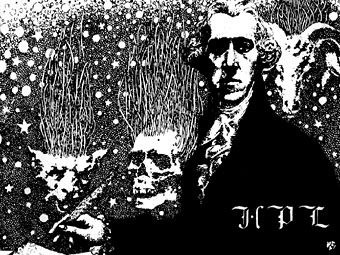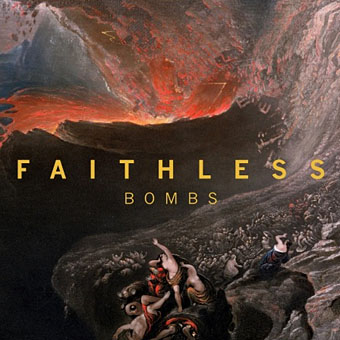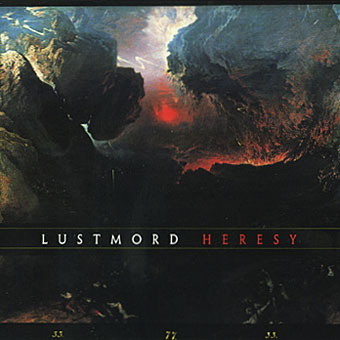
HP Lovecraft by Virgil Finlay, 1937.
A journal by artist and designer John Coulthart.
The oft-despised concept album of the 1970s doesn’t come more demented than 666, a double disc set by Greek group Aphrodite’s Child released in 1972. The group featured Vangelis and Demis Roussos among their number (Roussos later turned up on Vangelis’s score for Blade Runner) and this is about the only thing they’re now remembered for, a post-psychedelic fantasy based on the Book of Revelations. So far, so heavy. Searching for information about the album turned up a proposal by Salvador Dalí for a celebratory “happening” to be staged in Barcelona for the album’s world premiere (lyricist Costas Ferris having met Dalí in Paris shortly after the recording):
The main concept:
1. Martial Law shall be ordered on a Sunday, in Barcelona. No one shall be allowed to walk in the streets, or watch the event. No cameras, no TV. Only a young couple of shepherds will have the privilege to witness the event. So, they can later describe it to the people, by oral speech.
2. Giant loudspeakers shall be put in the streets, playing all day the work 666, by Vangelis, Ferris and the Aphrodite’s Child. No live performance.
3. Soldiers dressed in Nazi uniforms, will walk in military march in the streets of Barcelona, arresting who-ever wants to break the law.
4. Hundreds of swans will be left to move in front of the Sagrada Famiglia, with pieces of dynamite in their bellies, which will explode in slow motion by special effects. (real living swans, that should be operated for putting the dynamite inside their belly).
5. Giant Navy planes, will fly all day in the sky of Barcelona, provoking big noise.
6. At 12:00 sharp, in the mid-day, those planes will start the bombardment of the great church, throwing all of their munitions.
7. Instead of bombs, they shall throw Elephants, Hippopotami, Whales and Archbishops carrying umbrellas.
No, it didn’t happen, but if you do hear the album try and think of swans exploding in slow motion while elephants and archbishops rain down from the sky.
Previously on { feuilleton }
• The apocalyptic art of Francis Danby
• The music of Igor Wakhévitch
• Dalí Atomicus

The apocalyptic spectacles of Romantic painter John Martin are routinely treated by art critics as kitsch, a dismissal which ignores the considerable power and perennial attraction that many of his best pictures possess. Kitsch is a bad thing, it seems, unless you’re Jeff Koons or Jake and Dinos Chapman.
Martin’s most famous work, The Great Day of His Wrath, has raised its tumultuous head again on the cover of Bombs, a recent single by Faithless. The painting depicts a scene from the Book of Revelations with city-capped mountains being upturned onto terrified sinners while lightning cuts through the sky. The video for the song is an anti-war affair by Howard Greenhalgh, juxtaposing innocuous images of everday life with weapons being fired and soldiers being attacked, often in the same shot. So a happy family skips along a beach while a mushroom cloud grows on the horizon. The moral guardians at MTV have duly banned this in order to spare the delicate sensibilities of America’s teenagers. And they wonder why people like YouTube so much? Or Google Video?

Faithless are a bit late to John Martin’s table, Lustmord featured the painting in full on the cover of Heresy in 1990, an album whose doomy rumbles I much prefer to the duo’s lightweight soul. Better late than never, I suppose.
Previously on { feuilleton }
• The apocalyptic art of Francis Danby
• The Enigma of Desiderio
The Apotheosis of War (1871) by Vasili Vereshchagin, “dedicated to all conquerors, past, present and to come”.
Previously on { feuilleton }
• The apocalyptic art of Francis Danby
The Deluge (1840).
In the days before cinema and the likes of Roland Emmerich, people had to visit galleries or see touring exhibitions of huge paintings for their fill of artistic cataclysm. I discovered some of these works on my first visit to the Tate Gallery (now Tate Britain), aged 13. I was there to see favourite pictures by the Pop artists and Surrealists and so was completely unprepared for the room of three John Martin paintings and the awesome (and enormous) The Deluge by Francis Danby (1793–1861). These were pictures that never appeared in conventional art histories although subsequent scouring of libaries revealed at least one book devoted to Martin’s scenes of Biblical destruction. Danby, on the other hand, remained obscure, and for years this single painting was the only work of his that I’d seen.
Over the years I’ve come to prefer The Deluge to many of Martin’s paintings. His figures are larger and the draughtsmanship is better, the composition is more developed and the technical qualities (despite complaints in the article below) are superb. Like many painters of this period, Danby had great skill at rendering the translucence of water and the gorgeous texture of the waves in this painting was one of the first things to strike me (something that’s impossible see in books or online reproduction). Closer examination reveals detail of a kind that Martin usually buries or ignores, from the tiny ark sailing away on the horizon, to the lion clutching desperately at a branch to escape the water. Most curious of all, in the far right the painter has stranded a pair of anomalous Biblical figures, a glowing angel and what appears to be a drowned giant. The Deluge is probably Danby’s most accomplished work so it’s good to know it remains on public display.
The following article is seventeen years old and remains the only newspaper or magazine feature I’ve seen about Danby’s work to date.
An Attempt to illustrate the Opening of the Sixth Seal (1828).
Darkness Visible
Many of the sombre, apocalyptic works by the nineteenth-century painter Francis Danby have become darker still as the paint and varnish have deteriorated over the years. But now some have been successfully restored for a retrospective of his work.
Andrew Graham-Dixon
Saturday, February 11th 1989
The Independent
FRANCIS DANBY’S The Upas, or Poison Tree in the Island of Java, the smash sensation of the annual British Institution exhibition of 1820 and one of the most ambitious narrative paintings of its time, has languished in the obscurity of the V&A’s basement for more than a century. Recently restored, it is the focal point of the Danby retrospective that has been mounted jointly by the Bristol City Museum and Art Gallery and the Tate Gallery. The Upas Tree marked Francis Danby’s London debut, and in some style. Measuring 66in by 99in, Danby’s gloomy canvas was an enormous calling-card, his way of announcing that here, from provincial Bristol (via Ireland, his place of birth), was a young painter to be reckoned with.